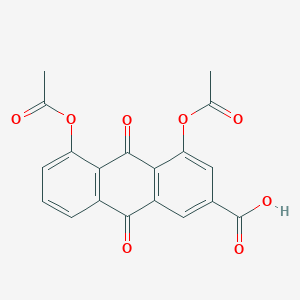-
Categories
-
Pharmaceutical Intermediates
-
Active Pharmaceutical Ingredients
-
Food Additives
- Industrial Coatings
- Agrochemicals
- Dyes and Pigments
- Surfactant
- Flavors and Fragrances
- Chemical Reagents
- Catalyst and Auxiliary
- Natural Products
- Inorganic Chemistry
-
Organic Chemistry
-
Biochemical Engineering
- Analytical Chemistry
- Cosmetic Ingredient
-
Pharmaceutical Intermediates
Promotion
ECHEMI Mall
Wholesale
Weekly Price
Exhibition
News
-
Trade Service
▎The content team editor of WuXi AppTec last week, Novavax and Johnson & Johnson successively announced the positive results obtained in phase 3 clinical trials of the new crown vaccine developed by each.
The results of these two clinical trials also pointed out that the protective efficacy of the two vaccines in clinical trials conducted in South Africa was significantly lower than that of other regions.
A further study of COVID-19 patients in clinical trials in South Africa found that more than 90% of the patients were infected with the B.
1.
351 new coronavirus mutant strain that was first discovered in South Africa recently.
This virus strain has been widely concerned by scientists since its appearance, because many in vitro experiments have shown that it can evade the recognition of certain neutralizing antibodies, thereby reducing the protective ability of the body's immune response.
The vaccine test results of Novavax and Johnson & Johnson also verified the results obtained from in vitro experiments from the perspective of human clinical trials.
Mapping by WuXi AppTec's content team So, what do we have to deal with these new coronavirus strains? What are the implications of these test results for the design of the new crown vaccine? Last week, many companies have stated that they are already developing a new generation of new coronavirus vaccines against mutant strains.
And Johnson & Johnson executives emphasized the importance of the vaccine to stimulate the human T cell immune response during the conference call to release the vaccine's Phase 3 clinical results.
The company's vaccine is 85% effective in protecting severe COVID-19, and its ability to protect against severe illness has not been affected by the B.
1.
351 mutant strain.
Johnson & Johnson executives pointed out that the strong T cell immune response stimulated by the vaccine may be one of the important reasons why the vaccine's protective ability against severe COVID-19 is not affected.
The T cell immune response is an important part of the human immune response.
The activation of CD4 positive T cells can help B cells generate neutralizing antibodies and activate CD8 positive T cells.
CD8-positive T cells can eliminate virus-infected cells.
A few days ago, a study published in Cell Report Medicine, a sub-issue of "Cell", showed that.
The epitope of the new coronavirus recognized by human T cells is very different from the epitope recognized by the neutralizing antibody produced by B cells.
They are more diverse and are not limited to the receptor binding domain of spike proteins or spike proteins.
(RBD).
Even for the newly emerging new coronavirus mutant strains, most T cells can still maintain good recognition capabilities.
The researchers pointed out that this provides a good foundation for the prevention of severe COVID-19 and may further guide the direction of future vaccine design.
In this study, scientists obtained blood samples from 99 recovered COVID-19 patients and accurately detected the virus epitopes recognized by CD4-positive and CD8-positive T cells against the new coronavirus.
They found that the new coronavirus antigens recognized by CD4-positive and CD8-positive T cells are mainly distributed on 8-9 viral proteins.
In addition to the well-known spike protein (S protein), they also recognize membrane protein (M), nuclear Capsid protein (N), and non-structural proteins such as ORF3a and nsp12.
▲The epitopes recognized by CD4-positive and CD8-positive T cells in humans are very diverse (picture source: reference [2]).
Specific to the spike protein used in most vaccine developments, the epitopes recognized by CD4-positive T cells are also related to Neutralizing antibodies are very different.
The interesting point is that most of the spike protein epitopes recognized by CD4-positive T cells are not in the receptor binding domain (RBD), but in the N-terminal domain (NTD), C-terminal domain (CT) and Fusion protein (FP) domain.
These results mean that the human body's T cell immune response to the new coronavirus is very diverse and can target multiple different epitopes of the new coronavirus, so it is more difficult for the new coronavirus to escape the recognition of T cells through genetic mutations.
▲The epitope of the spike protein recognized by CD4-positive T cells is different from the neutralizing antibody (picture source: reference [2]).
Researchers also tested the ability of the B.
1.
1.
7 new coronavirus mutant virus strain that appeared in the United Kingdom to recognize T cells Impact.
They found that the epitopes affected by the B.
1.
1.
7 mutant only accounted for 8% of the total number of epitopes recognized by CD4-positive T cells, and 92% of the epitopes could still be recognized by T cells.
Professor Alessandro Sette of the La Jolla Institute for Immunoloy, one of the senior authors of this study, said that computational models show that the B.
1.
135 mutant strain can also be recognized by 90% of T cells.
"Although this may not be enough to prevent infection, it may make the disease a lot lighter.
" Professor Sette added.
In addition, the researchers also pointed out in the discussion section of the article that since the activation of CD4-positive T cells plays an important role in helping B cells produce antibodies and activating CD8-positive T cells, consideration should be given to this T cell when designing vaccines.
Type of activation ability.
The RBD of the spike protein itself lacks the epitope that activates CD4-positive T cells, and other parts of the spike protein should be considered when designing a vaccine to support sufficient CD4-positive T cell activation.
The results of these two clinical trials also pointed out that the protective efficacy of the two vaccines in clinical trials conducted in South Africa was significantly lower than that of other regions.
A further study of COVID-19 patients in clinical trials in South Africa found that more than 90% of the patients were infected with the B.
1.
351 new coronavirus mutant strain that was first discovered in South Africa recently.
This virus strain has been widely concerned by scientists since its appearance, because many in vitro experiments have shown that it can evade the recognition of certain neutralizing antibodies, thereby reducing the protective ability of the body's immune response.
The vaccine test results of Novavax and Johnson & Johnson also verified the results obtained from in vitro experiments from the perspective of human clinical trials.
Mapping by WuXi AppTec's content team So, what do we have to deal with these new coronavirus strains? What are the implications of these test results for the design of the new crown vaccine? Last week, many companies have stated that they are already developing a new generation of new coronavirus vaccines against mutant strains.
And Johnson & Johnson executives emphasized the importance of the vaccine to stimulate the human T cell immune response during the conference call to release the vaccine's Phase 3 clinical results.
The company's vaccine is 85% effective in protecting severe COVID-19, and its ability to protect against severe illness has not been affected by the B.
1.
351 mutant strain.
Johnson & Johnson executives pointed out that the strong T cell immune response stimulated by the vaccine may be one of the important reasons why the vaccine's protective ability against severe COVID-19 is not affected.
The T cell immune response is an important part of the human immune response.
The activation of CD4 positive T cells can help B cells generate neutralizing antibodies and activate CD8 positive T cells.
CD8-positive T cells can eliminate virus-infected cells.
A few days ago, a study published in Cell Report Medicine, a sub-issue of "Cell", showed that.
The epitope of the new coronavirus recognized by human T cells is very different from the epitope recognized by the neutralizing antibody produced by B cells.
They are more diverse and are not limited to the receptor binding domain of spike proteins or spike proteins.
(RBD).
Even for the newly emerging new coronavirus mutant strains, most T cells can still maintain good recognition capabilities.
The researchers pointed out that this provides a good foundation for the prevention of severe COVID-19 and may further guide the direction of future vaccine design.
In this study, scientists obtained blood samples from 99 recovered COVID-19 patients and accurately detected the virus epitopes recognized by CD4-positive and CD8-positive T cells against the new coronavirus.
They found that the new coronavirus antigens recognized by CD4-positive and CD8-positive T cells are mainly distributed on 8-9 viral proteins.
In addition to the well-known spike protein (S protein), they also recognize membrane protein (M), nuclear Capsid protein (N), and non-structural proteins such as ORF3a and nsp12.
▲The epitopes recognized by CD4-positive and CD8-positive T cells in humans are very diverse (picture source: reference [2]).
Specific to the spike protein used in most vaccine developments, the epitopes recognized by CD4-positive T cells are also related to Neutralizing antibodies are very different.
The interesting point is that most of the spike protein epitopes recognized by CD4-positive T cells are not in the receptor binding domain (RBD), but in the N-terminal domain (NTD), C-terminal domain (CT) and Fusion protein (FP) domain.
These results mean that the human body's T cell immune response to the new coronavirus is very diverse and can target multiple different epitopes of the new coronavirus, so it is more difficult for the new coronavirus to escape the recognition of T cells through genetic mutations.
▲The epitope of the spike protein recognized by CD4-positive T cells is different from the neutralizing antibody (picture source: reference [2]).
Researchers also tested the ability of the B.
1.
1.
7 new coronavirus mutant virus strain that appeared in the United Kingdom to recognize T cells Impact.
They found that the epitopes affected by the B.
1.
1.
7 mutant only accounted for 8% of the total number of epitopes recognized by CD4-positive T cells, and 92% of the epitopes could still be recognized by T cells.
Professor Alessandro Sette of the La Jolla Institute for Immunoloy, one of the senior authors of this study, said that computational models show that the B.
1.
135 mutant strain can also be recognized by 90% of T cells.
"Although this may not be enough to prevent infection, it may make the disease a lot lighter.
" Professor Sette added.
In addition, the researchers also pointed out in the discussion section of the article that since the activation of CD4-positive T cells plays an important role in helping B cells produce antibodies and activating CD8-positive T cells, consideration should be given to this T cell when designing vaccines.
Type of activation ability.
The RBD of the spike protein itself lacks the epitope that activates CD4-positive T cells, and other parts of the spike protein should be considered when designing a vaccine to support sufficient CD4-positive T cell activation.







